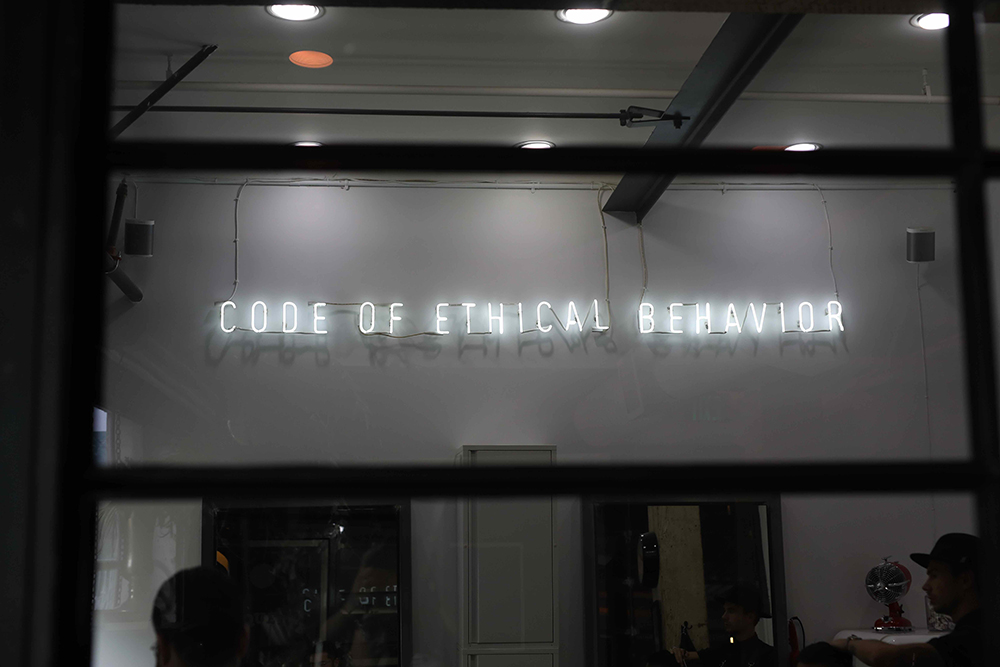Machine ethics, which was often dismissed as a curiosity ten years ago, is now part of everyday business. It is required, for example, when so-called guardrails are used in language models or chatbots, via alignment in the form of fine-tuning or via prompt engineering. When you create GPTs, i.e. “custom versions of ChatGPT”, as Open AI calls them, you have the “Instructions” field available for prompt engineering. Here, the “prompteur” or “prompreuse” can create certain specifications and restrictions for the chatbot. This can include references to documents that have been uploaded. This is exactly what Myriam Rellstab is currently doing at the FHNW School of Business as part of her final thesis “Moral Prompt Engineering”, the interim results of which she presented on May 28, 2024. As a “prompteuse”, she tames GPT-4o with the help of her instructions and – as suggested by the initiator of the project, Prof. Dr. Oliver Bendel – with the help of netiquettes that she has collected and made available to the chatbot. The chatbot is tamed, the tiger becomes a house cat that can be used without danger in the classroom, for example. With GPT-4o, guardrails have already been introduced beforehand. These were programmed in or obtained via reinforcement learning from human feedback. So, strictly speaking, you turn a tamed tiger into a house cat. This is different with certain open source language models. The wild animal must first be captured and then tamed. And even then it can seriously injure you. But even with GPTs there are pitfalls, and as we know, house tigers can hiss and scratch. The results of the project will be available in August. Moral prompt engineering had already been applied to Data, a chatbot for the Data Science course at the FHNW School of Engineering (Image: Ideogram).
The MOML Project
In many cases it is important that an autonomous system acts and reacts adequately from a moral point of view. There are some artifacts of machine ethics, e.g., GOODBOT or LADYBIRD by Oliver Bendel or Nao as a care robot by Susan Leigh and Michael Anderson. But there is no standardization in the field of moral machines yet. The MOML project, initiated by Oliver Bendel, is trying to work in this direction. In the management summary of his bachelor thesis Simon Giller writes: “We present a literature review in the areas of machine ethics and markup languages which shaped the proposed morality markup language (MOML). To overcome the most substantial problem of varying moral concepts, MOML uses the idea of the morality menu. The menu lets humans define moral rules and transfer them to an autonomous system to create a proxy morality. Analysing MOML excerpts allowed us to develop an XML schema which we then tested in a test scenario. The outcome is an XML based morality markup language for autonomous agents. Future projects can use this language or extend it. Using the schema, anyone can write MOML documents and validate them. Finally, we discuss new opportunities, applications and concerns related to the use of MOML. Future work could develop a controlled vocabulary or an ontology defining terms and commands for MOML.” The bachelor thesis will be publicly available in autumn 2020. It was supervised by Dr. Elzbieta Pustulka. There will also be a paper with the results next year.
Moral and Immoral Machines
Since 2012, Oliver Bendel has invented 13 artifacts of machine ethics. Nine of them have actually been implemented, including LADYBIRD, the animal-friendly vacuum cleaning robot, and LIEBOT, the chatbot that can systematically lie. Both of them have achieved a certain popularity. The information and machine ethicist is convinced that ethics does not necessarily have to produce the good. It should explore the good and the evil and, like any science, serve to gain knowledge. Accordingly, he builds both moral and immoral machines. But the immoral ones he keeps in his laboratory. In 2020, if the project is accepted, HUGGIE will see the light of day. The project idea is to create a social robot that contributes directly to a good life and economic success by touching and hugging people and especially customers. HUGGIE should be able to warm up in some places, and it should be possible to change the materials it is covered with. A research question will be: What are the possibilities besides warmth and softness? Are optical stimuli (also on displays), vibrations, noises, voices etc. important for a successful hug? All moral and immoral machines that have been created between 2012 and 2020 are compiled in a new illustration, which is shown here for the first time.
Opportunities and Risks of Facial Recognition
The book chapter “The BESTBOT Project” by Oliver Bendel, David Studer and Bradley Richards was published on 31 December 2019. It is part of the 2nd edition of the “Handbuch Maschinenethik”, edited by Oliver Bendel. From the abstract: “The young discipline of machine ethics both studies and creates moral (or immoral) machines. The BESTBOT is a chatbot that recognizes problems and conditions of the user with the help of text analysis and facial recognition and reacts morally to them. It can be seen as a moral machine with some immoral implications. The BESTBOT has two direct predecessor projects, the GOODBOT and the LIEBOT. Both had room for improvement and advancement; thus, the BESTBOT project used their findings as a basis for its development and realization. Text analysis and facial recognition in combination with emotion recognition have proven to be powerful tools for problem identification and are part of the new prototype. The BESTBOT enriches machine ethics as a discipline and can solve problems in practice. At the same time, with new solutions of this kind come new problems, especially with regard to privacy and informational autonomy, which information ethics must deal with.” (Abstract) The book chapter can be downloaded from link.springer.com/referenceworkentry/10.1007/978-3-658-17484-2_32-1.
From Logic Programming to Machine Ethics
Luís Moniz Pereira is one of the best known and most active machine ethicists in the world. Together with his colleague Ari Saptawijaya he wrote the article “From Logic Programming to Machine Ethics” for the “Handbuch Maschinenethik” (“Handbook Machine Ethics”). From the abstract: “This chapter investigates the appropriateness of Logic Programming-based reasoning to machine ethics, an interdisciplinary field of inquiry that emerges from the need of imbuing autonomous agents with the capacity for moral decision making. The first part of the chapter aims at identifying morality viewpoints, as studied in moral philosophy and psychology, which are amenable to computational modeling, and then mapping them to appropriate Logic Programming-based reasoning features. The identified viewpoints are covered by two morality themes: moral permissibility and the dual-process model. In the second part, various Logic Programming-based reasoning features are applied to model these identified morality viewpoints, via classic moral examples taken off-the-shelf from the literature. For this purpose, our QUALM system mainly employs a combination of the Logic Programming features of abduction, updating, and counterfactuals. These features are all supported jointly by Logic Programming tabling mechanisms. The applications are also supported by other existing Logic Programming based systems, featuring preference handling and probabilistic reasoning, which complement QUALM in addressing the morality viewpoints in question. Throughout the chapter, many references to our published work are given, providing further examples and details about each topic. Thus, this chapter can be envisaged as an entry point survey on the employment of Logic Programming for knowledge modelling and technically implementing machine ethics.” (Abstract) Springer VS published the “Handbuch Maschinenethik” in October 2019. Editor is Oliver Bendel (Zurich, Switzerland).
Learning How to Behave
In October 2019 Springer VS published the “Handbuch Maschinenethik” (“Handbook Machine Ethics”) with German and English contributions. Editor is Oliver Bendel (Zurich, Switzerland). One of the articles was written by Bertram F. Malle (Brown University, Rhode Island) and Matthias Scheutz (Tufts University, Massachusetts). From the abstract: “We describe a theoretical framework and recent research on one key aspect of robot ethics: the development and implementation of a robot’s moral competence. As autonomous machines take on increasingly social roles in human communities, these machines need to have some level of moral competence to ensure safety, acceptance, and justified trust. We review the extensive and complex elements of human moral competence and ask how analogous competences could be implemented in a robot. We propose that moral competence consists of five elements, two constituents (moral norms and moral vocabulary) and three activities (moral judgment, moral action, and moral communication). A robot’s computational representations of social and moral norms is a prerequisite for all three moral activities. However, merely programming in advance the vast network of human norms is impossible, so new computational learning algorithms are needed that allow robots to acquire and update the context-specific and graded norms relevant to their domain of deployment. Moral vocabulary is needed primarily for moral communication, which expresses moral judgments of others’ violations and explains one’s own moral violations – to justify them, apologize, or declare intentions to do better. Current robots have at best rudimentary moral competence, but with improved learning and reasoning they may begin to show the kinds of capacities that humans will expect of future social robots.” (Abstract “Handbuch Maschinenethik”). The book is available via www.springer.com.
A Markup Language for Moral Machines
A markup language is a machine-readable language for structuring and formatting texts and other data. The best known is the Hypertext Markup Language (HTML). Other well-known artifacts are SSML (for the adaptation of synthetic voices) and AIML (for artificial intelligence applications). We use markup languages to describe properties, affiliations and forms of representation of sections of a text or set of data. This is usually done by marking them with tags. In addition to tags, attributes and values can also be important. A student paper at the School of Business FHNW will describe and compare known markup languages. It will examine whether there is room for further artifacts of this kind. A markup language, which would be suitable for the morality in the written and spoken as well as the morally adequate display of pictures, videos and animations and the playing of sounds, could be called MOML (Morality Markup Language). Is such a language possible and helpful? Can it be used for moral machines? The paper will also deal with this. The supervisor of the project, which will last until the end of the year, is Prof. Dr. Oliver Bendel. Since 2012, he and his teams have created formulas and annotated decision trees for moral machines and a number of moral machines themselves, such as GOODBOT, LIEBOT, BESTBOT, and LADYBIRD.
The Future of Autonomous Driving
Driving in cities is a very complex matter. There are several reasons for this: You have to judge hundreds of objects and events at all times. You have to communicate with people. And you should be able to change decisions spontaneously, for example because you remember that you have to buy something. That’s a bad prospect for an autonomous car. Of course it can do some tricks: It can drive very slowly. It can use virtual tracks or special lanes and signals and sounds. A bus or shuttle is able to use such tricks. But hardly a car. Autonomous individual transport in cities will only be possible if the cities are redesigned. This has been done a few decades ago. And it wasn’t a good idea at all. So don’t let autonomous cars drive in the cities, but let them drive on the highways. Should autonomous cars make moral decisions about the lives and deaths of pedestrians and cyclists? They should better not. Moral machines are a valuable innovation in certain contexts. But not in the traffic of cities. Pedestrians and cyclists rarely get onto the highway. There are many reasons why we should allow autonomous cars only there.
Ethical and Statistical Considerations in Models of Moral Judgments
Torty Sivill works at the Computer Science Department, University of Bristol. In August 2019 she published the article “Ethical and Statistical Considerations in Models of Moral Judgments”. “This work extends recent advancements in computational models of moral decision making by using mathematical and philosophical theory to suggest adaptations to state of the art. It demonstrates the importance of model assumptions and considers alternatives to the normal distribution when modeling ethical principles. We show how the ethical theories, utilitarianism and deontology can be embedded into informative prior distributions. We continue to expand the state of the art to consider ethical dilemmas beyond the Trolley Problem and show the adaptations needed to address this complexity. The adaptations made in this work are not solely intended to improve recent models but aim to raise awareness of the importance of interpreting results relative to assumptions made, either implicitly or explicitly, in model construction.” (Abstract) The article can be accessed via https://www.frontiersin.org/articles/10.3389/frobt.2019.00039/full.
Development of a Morality Menu
Machine ethics produces moral and immoral machines. The morality is usually fixed, e.g. by programmed meta-rules and rules. The machine is thus capable of certain actions, not others. However, another approach is the morality menu (MOME for short). With this, the owner or user transfers his or her own morality onto the machine. The machine behaves in the same way as he or she would behave, in detail. Together with his teams, Prof. Dr. Oliver Bendel developed several artifacts of machine ethics at his university from 2013 to 2018. For one of them, he designed a morality menu that has not yet been implemented. Another concept exists for a virtual assistant that can make reservations and orders for its owner more or less independently. In the article “The Morality Menu” the author introduces the idea of the morality menu in the context of two concrete machines. Then he discusses advantages and disadvantages and presents possibilities for improvement. A morality menu can be a valuable extension for certain moral machines. You can download the article here. In 2019, a morality menu for a robot will be developed at the School of Business FHNW.









